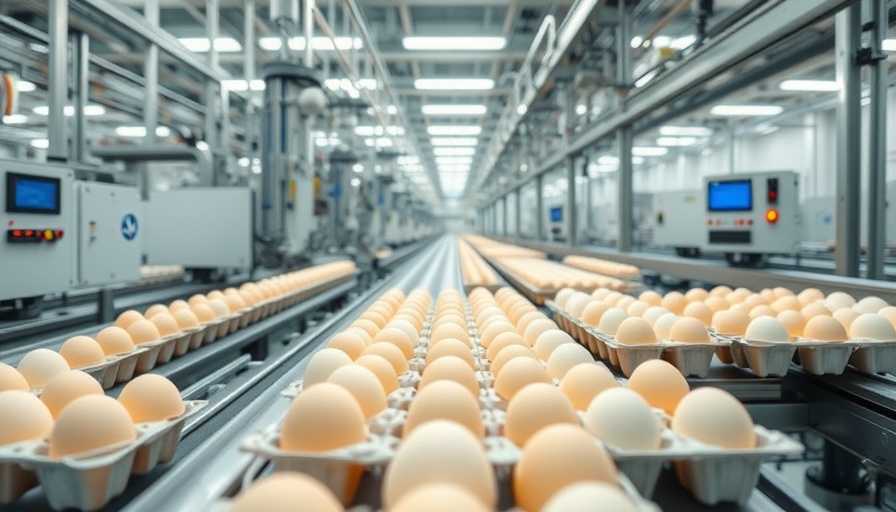
Sanitizing Egg Packaging Systems: A Vital Step for Home Health
Eggs are a staple in many MidSouth homes, cherished for their nutritional richness and versatility. However, the safety and quality of the eggs we consume depend significantly on how well they are packaged and sanitized. Given the recent avian flu outbreaks, understanding the importance of sanitizing egg packaging systems is more crucial than ever for maintaining health and safety in our kitchens.
Understanding the Risks: Bacteria and Egg Production
While many homeowners focus on the freshness and quality of the eggs themselves, they may overlook the potential contaminants present in the packaging and handling processes. Bacteria such as Salmonella and Escherichia coli can thrive on egg cartons and machinery, posing health risks if not properly managed. That’s why adopting stringent sanitization practices in egg processing is essential—not only for producers but also for consumers.
Essential Steps for Home Egg Safety
Here are several key steps that egg producers and processors implement to ensure safe packaging systems. It’s imperative that homeowners understand these practices as they can mirror their effort to maintain cleanliness in their kitchens.
1. Routine Debris Removal
Before applying any sanitizing agents, it is crucial to remove any debris such as egg shells and dust from the surfaces. This initial cleanup helps keep the microbial load down, ensuring that the eggs are packaged in a clean environment. Unless you are handling fresh eggs, it’s a good practice to wipe down your counter surfaces regularly.
2. Choose Safe Detergents
Applying food-grade detergents tailored for safe cleaning is vital. After cleaning, a thorough rinse is necessary to eliminate any residue that could harm health. Homeowners should consider using detergents that adhere to safety standards. Ensure that any cleaning solution used in your kitchen is safe for food contact.
3. Effectively Employ Sanitizers
After washing, the next step is to apply effective sanitizers like hydrogen peroxide or quaternary ammonium compounds. These have proven efficacy in drastically reducing bacterial presence. Homeowners should apply this philosophy in their food prep areas, using appropriate sanitizers for kitchen surfaces.
4. Design for Hygiene
Opting for kitchen tools that are easy to disassemble and clean can minimize contamination. Similarly, setting aside zones in your kitchen specifically for different types of food preparation can serve to prevent any cross-contamination. Good kitchen practices reflect those seen in food processing lines, bridging the gap between commercial methods and home hygiene.
5. Document and Verify Cleaning Practices
Keeping a record of when and how your kitchen equipment gets cleaned can be immensely beneficial for ensuring ongoing safety. Although not commonly practiced in home settings, it can instill a strong habit that promotes a clean and healthy cooking environment. Just as producers document their sanitization processes, homeowners can maintain logs for their routines.
The Bigger Picture: Why It Matters
By understanding and implementing these sanitation practices, homeowners become proactive in safeguarding their health and that of their families. Each step taken in maintaining cleanliness can significantly reduce the risk of foodborne illnesses.
Future of Sanitization in Food Safety
As the food industry continually evolves, so does the approach towards sanitation. New technologies and sanitation methods are emerging to make food handling and packaging safer than ever before. Homeowners should stay informed about these innovations and consider trends in food safety as a part of their health awareness journey.
Empower Yourself with Knowledge
Ultimately, knowledge about sanitizing practices empowers homeowners to take charge of their food safety. While it’s easy to overlook the small details in our kitchens, each element—be it the egg carton or the countertop—plays a crucial role in our overall health. By adopting these practices at home, you not only protect your family but also contribute to a broader culture of health and safety.
Take Action Today!
Keeping our kitchens safe is a continuous journey. Next time you handle eggs, think critically about where they come from and the processes they undergo. Whether it’s cleaning your surfaces effectively or choosing the right products, you can create a healthier environment in your home.
 Add Row
Add Row  Add
Add 



 Add Row
Add Row  Add
Add 
Write A Comment